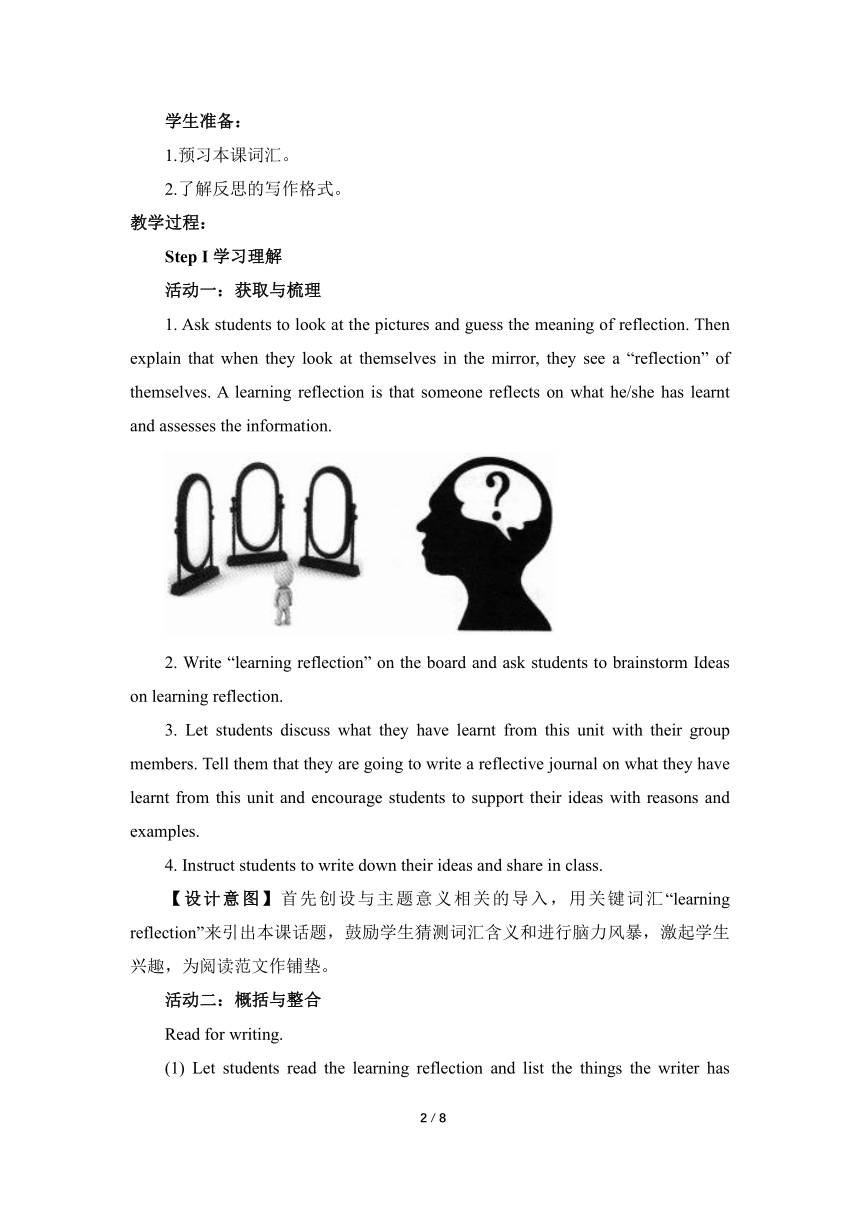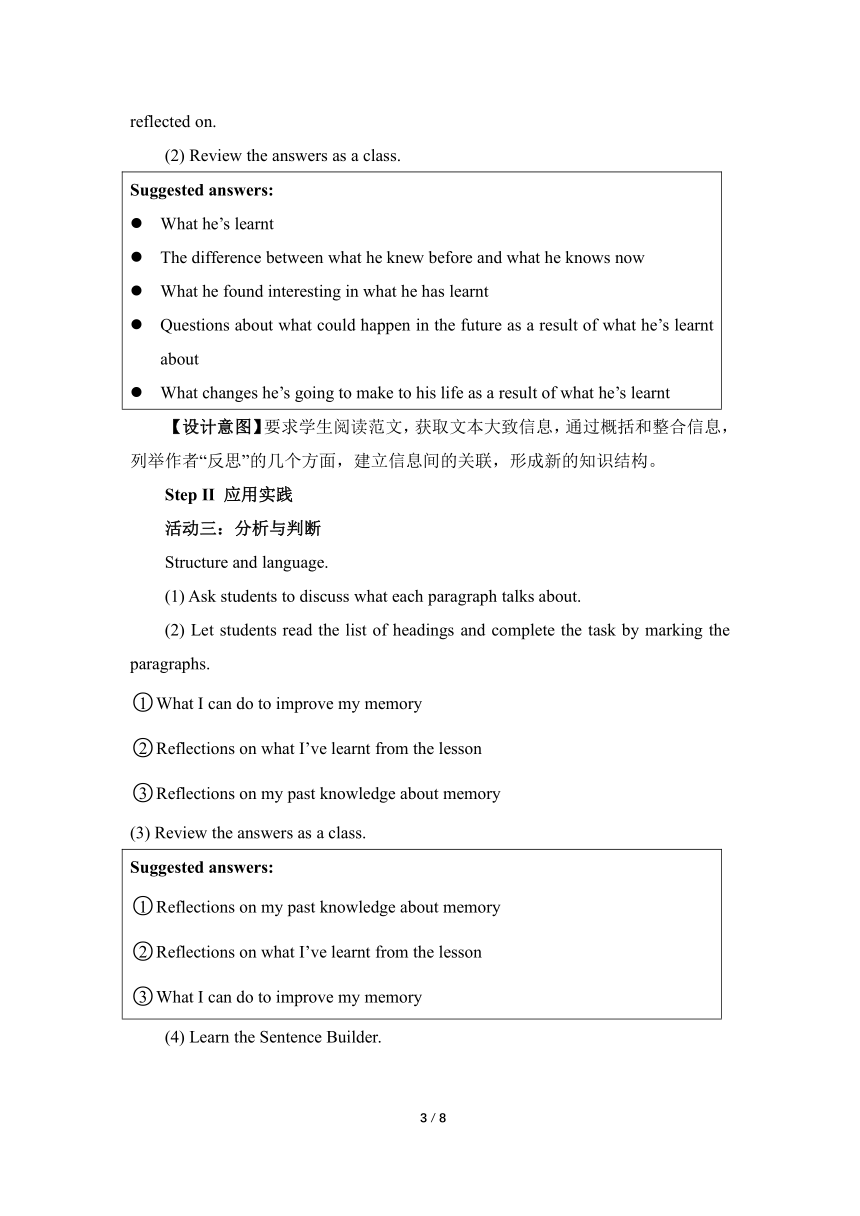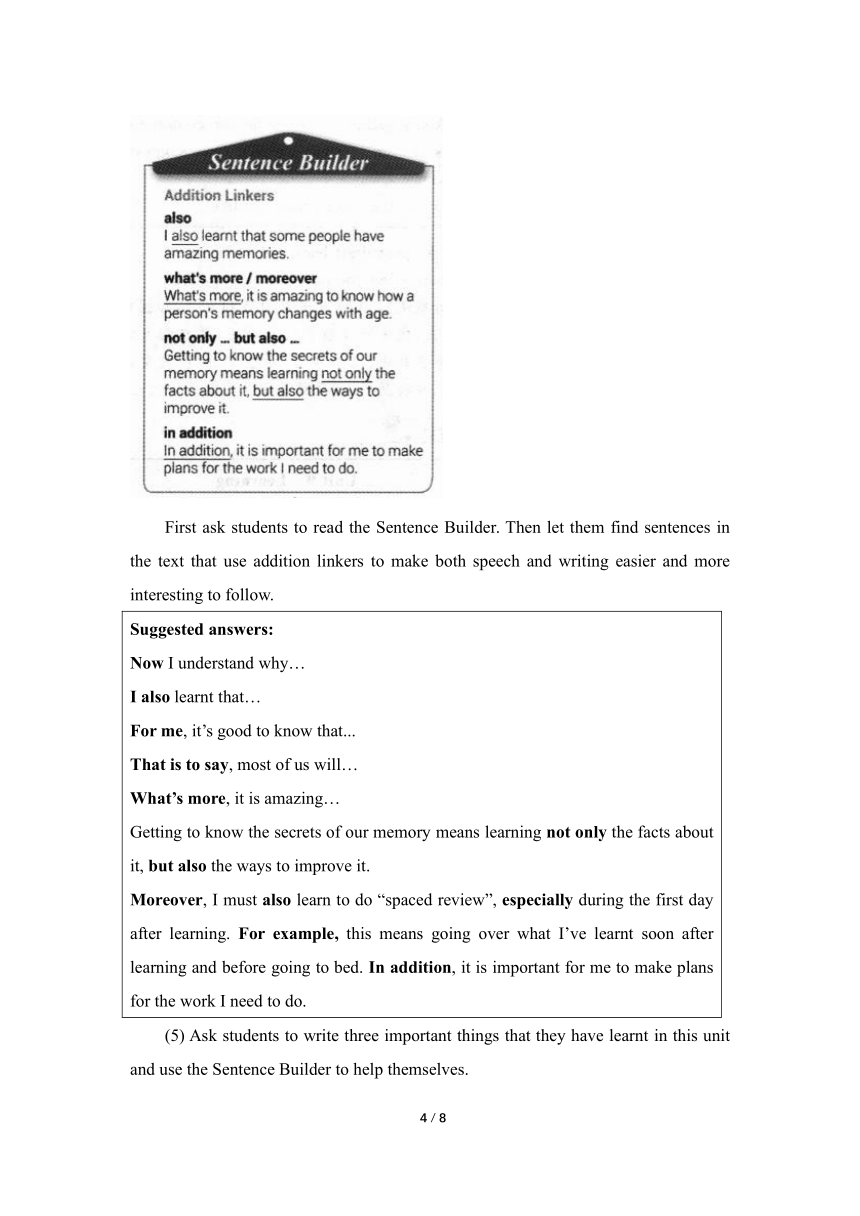北师大版(2019)必修 第三册Unit 9 Learning Writing Workshop名师教学设计
文档属性
| 名称 | 北师大版(2019)必修 第三册Unit 9 Learning Writing Workshop名师教学设计 |

|
|
| 格式 | docx | ||
| 文件大小 | 455.7KB | ||
| 资源类型 | 教案 | ||
| 版本资源 | 北师大版(2019) | ||
| 科目 | 英语 | ||
| 更新时间 | 2023-03-07 22:03:29 | ||
图片预览




文档简介
Unit 9 Writing Workshop 名师教学设计
课时内容:
A Learning Reflection
主题语境:人与自我
主题群:生活与学习
子主题:乐于学习,善于学习,终身学习
语篇类型:说明文
文本分析:
[What]本节课提供了一篇关于学习某一话题后反思范文,文章分为三个自然段:第一自然段介绍自己对该话题已有的知识和认识;第二自然段反思自己所学到的知识;最后一段呈现将来自己的打算和计划。
[Why]学会借用连接词和采用三段式来写一篇反思培养学生获取信息并利用所学语言、文化知识创造新语篇的能力以及批判性思维。
[How]本课提供的范文为一篇学习反思,文章采用三段式来表达“过去所学、现在所获、将来所做”。作者使用了大量的连接词使文章结构更加清晰。
课时目标:
1.获取、梳理和描述反思中的细节和主要信息。
2.分析、判断语篇的文体特征、三段式结构和语言特点。
3.根据框架和借助连接词,针对本单元所学的一课写一篇反思。
4.通过小组合作,对组内成员的文章进行批判性评价并相互学习,培养学生批判性思维及与他人合作学习的能力。
重点难点:
重点:
掌握反思的文体结构。
难点:
写一篇反思并修改和润色。
教学准备:
教师准备:
反思的结构。
学生准备:
1.预习本课词汇。
2.了解反思的写作格式。
教学过程:
Step I学习理解
活动一:获取与梳理
1. Ask students to look at the pictures and guess the meaning of reflection. Then explain that when they look at themselves in the mirror, they see a “reflection” of themselves. A learning reflection is that someone reflects on what he/she has learnt and assesses the information.
2. Write “learning reflection” on the board and ask students to brainstorm Ideas on learning reflection.
3. Let students discuss what they have learnt from this unit with their group members. Tell them that they are going to write a reflective journal on what they have learnt from this unit and encourage students to support their ideas with reasons and examples.
4. Instruct students to write down their ideas and share in class.
【设计意图】首先创设与主题意义相关的导入,用关键词汇“learning reflection”来引出本课话题,鼓励学生猜测词汇含义和进行脑力风暴,激起学生兴趣,为阅读范文作铺垫。
活动二:概括与整合
Read for writing.
(1) Let students read the learning reflection and list the things the writer has reflected on.
(2) Review the answers as a class.
Suggested answers: What he’s learnt The difference between what he knew before and what he knows now What he found interesting in what he has learnt Questions about what could happen in the future as a result of what he’s learnt about What changes he’s going to make to his life as a result of what he’s learnt
【设计意图】要求学生阅读范文,获取文本大致信息,通过概括和整合信息,列举作者“反思”的几个方面,建立信息间的关联,形成新的知识结构。
Step Ⅱ 应用实践
活动三:分析与判断
Structure and language.
(1) Ask students to discuss what each paragraph talks about.
(2) Let students read the list of headings and complete the task by marking the paragraphs.
What I can do to improve my memory
Reflections on what I’ve learnt from the lesson
Reflections on my past knowledge about memory
(3) Review the answers as a class.
Suggested answers: Reflections on my past knowledge about memory Reflections on what I’ve learnt from the lesson What I can do to improve my memory
(4) Learn the Sentence Builder.
First ask students to read the Sentence Builder. Then let them find sentences in the text that use addition linkers to make both speech and writing easier and more interesting to follow.
Suggested answers: Now I understand why… I also learnt that… For me, it’s good to know that... That is to say, most of us will… What’s more, it is amazing… Getting to know the secrets of our memory means learning not only the facts about it, but also the ways to improve it. Moreover, I must also learn to do “spaced review”, especially during the first day after learning. For example, this means going over what I’ve learnt soon after learning and before going to bed. In addition, it is important for me to make plans for the work I need to do.
(5) Ask students to write three important things that they have learnt in this unit and use the Sentence Builder to help themselves.
【设计意图】通过探索三个自然段的主旨大意,了解反思的结构;在文章中寻找连接词,了解连接词的用法和意义,为下一步的写作提供足量的语言输入。
活动四:内化与应用
1. Outlining
Encourage students to complete the outline of their reflection.
2. Explore more addition linkers.
(1)表示承接的过渡词汇:also, and, and then, too, in addition, furthermore, moreover, what’s more, again, on top of that, another, first, second, third, fourth等。
(2)表示时间顺序的过渡词汇:now, then, before, after, afterwards, earlier, later, immediately, soon, next, in a few days, gradually, suddenly, finally等。
(3)表示空间顺序的过渡词汇: near (to), far (from), in front of, behind, beside, beyond, above, below, to the right/left, around, outside等。
(4)表示比较的过渡词汇: in the same way, just like, Just as等。
(5)表示转折的过渡词汇: but, still, yet, however, never, on the contrary, in spite of/in spite of the fact that, even though, although, despite/despite the fact that等。
(6)一方面,另一方面: on the one hand, on the other hand, for one thing, for another等。
(7)表示结果和原因的过渡词汇: because, Since, so, as a result, therefore等。
(8)表示目的的过渡词汇: for this reason, for this purpose, so that, in order to等。
(9)表示强调的过渡词汇: in fact, indeed, surely, necessarily, certainly, without any doubt, truly, above all等。
(10)表示解释说明的过渡词汇: for example, in fact, in this case, for instance等。
(11)表示总结的过渡词汇:in a word, all in all, finally, at last, in conclusion, as I have shown, in another word, in brief, in short, in general, on the whole, as has been stated, last but not least, in addition等。
3. Drafting.
Instruct students to learn the Writing Help and use their outline and the Writing Help to write the first draft. Students make sure that the sentences and paragraphs are properly linked.
【设计意图】从整体角度出发,概括出反思的大纲,提供一系列的连接词供学生参考。随后指导学生完成初稿,逐步实现对语言知识和文化知识的内化,促进语言运用的自动化,助力学生将知识转化为能力。
Step Ⅲ 迁移创新
活动五:批判与评价
Let students exchange their writing with a partner.
1. Use the Peer Editing Sheet for Unit 9 on Page 93 to help you review your partner’s draft.
Mark any spelling, punctuation or grammar errors. Mark any unclear expressions. Give suggestions if you can. Underline the expressions you like.
2. Take your draft back and revise it.
3. Share what you have written in class.
【设计意图】鼓励学生开展自评和互评,加强学生之间的互动交流,促进自我监督式的学习,并在相互评价中不断反思、取长补短、总结经验、调控学习,把教学评价变成主体参与、自我反思、相互激励和共同发展的过程和手段。
板书设计:
Unit 9 Learning Period V Writing Workshop I.学习理解 活动一:获取与梳理 活动二:概括与整合 Read for writing. Ⅱ.应用实践 活动三:分析与判断 Structure and language 活动四:内化与应用 1. Outlining. 2. Explore more addition linker. 3. Drafting. Ⅲ.迁移创新 活动五:批判与评价
2 / 2
课时内容:
A Learning Reflection
主题语境:人与自我
主题群:生活与学习
子主题:乐于学习,善于学习,终身学习
语篇类型:说明文
文本分析:
[What]本节课提供了一篇关于学习某一话题后反思范文,文章分为三个自然段:第一自然段介绍自己对该话题已有的知识和认识;第二自然段反思自己所学到的知识;最后一段呈现将来自己的打算和计划。
[Why]学会借用连接词和采用三段式来写一篇反思培养学生获取信息并利用所学语言、文化知识创造新语篇的能力以及批判性思维。
[How]本课提供的范文为一篇学习反思,文章采用三段式来表达“过去所学、现在所获、将来所做”。作者使用了大量的连接词使文章结构更加清晰。
课时目标:
1.获取、梳理和描述反思中的细节和主要信息。
2.分析、判断语篇的文体特征、三段式结构和语言特点。
3.根据框架和借助连接词,针对本单元所学的一课写一篇反思。
4.通过小组合作,对组内成员的文章进行批判性评价并相互学习,培养学生批判性思维及与他人合作学习的能力。
重点难点:
重点:
掌握反思的文体结构。
难点:
写一篇反思并修改和润色。
教学准备:
教师准备:
反思的结构。
学生准备:
1.预习本课词汇。
2.了解反思的写作格式。
教学过程:
Step I学习理解
活动一:获取与梳理
1. Ask students to look at the pictures and guess the meaning of reflection. Then explain that when they look at themselves in the mirror, they see a “reflection” of themselves. A learning reflection is that someone reflects on what he/she has learnt and assesses the information.
2. Write “learning reflection” on the board and ask students to brainstorm Ideas on learning reflection.
3. Let students discuss what they have learnt from this unit with their group members. Tell them that they are going to write a reflective journal on what they have learnt from this unit and encourage students to support their ideas with reasons and examples.
4. Instruct students to write down their ideas and share in class.
【设计意图】首先创设与主题意义相关的导入,用关键词汇“learning reflection”来引出本课话题,鼓励学生猜测词汇含义和进行脑力风暴,激起学生兴趣,为阅读范文作铺垫。
活动二:概括与整合
Read for writing.
(1) Let students read the learning reflection and list the things the writer has reflected on.
(2) Review the answers as a class.
Suggested answers: What he’s learnt The difference between what he knew before and what he knows now What he found interesting in what he has learnt Questions about what could happen in the future as a result of what he’s learnt about What changes he’s going to make to his life as a result of what he’s learnt
【设计意图】要求学生阅读范文,获取文本大致信息,通过概括和整合信息,列举作者“反思”的几个方面,建立信息间的关联,形成新的知识结构。
Step Ⅱ 应用实践
活动三:分析与判断
Structure and language.
(1) Ask students to discuss what each paragraph talks about.
(2) Let students read the list of headings and complete the task by marking the paragraphs.
What I can do to improve my memory
Reflections on what I’ve learnt from the lesson
Reflections on my past knowledge about memory
(3) Review the answers as a class.
Suggested answers: Reflections on my past knowledge about memory Reflections on what I’ve learnt from the lesson What I can do to improve my memory
(4) Learn the Sentence Builder.
First ask students to read the Sentence Builder. Then let them find sentences in the text that use addition linkers to make both speech and writing easier and more interesting to follow.
Suggested answers: Now I understand why… I also learnt that… For me, it’s good to know that... That is to say, most of us will… What’s more, it is amazing… Getting to know the secrets of our memory means learning not only the facts about it, but also the ways to improve it. Moreover, I must also learn to do “spaced review”, especially during the first day after learning. For example, this means going over what I’ve learnt soon after learning and before going to bed. In addition, it is important for me to make plans for the work I need to do.
(5) Ask students to write three important things that they have learnt in this unit and use the Sentence Builder to help themselves.
【设计意图】通过探索三个自然段的主旨大意,了解反思的结构;在文章中寻找连接词,了解连接词的用法和意义,为下一步的写作提供足量的语言输入。
活动四:内化与应用
1. Outlining
Encourage students to complete the outline of their reflection.
2. Explore more addition linkers.
(1)表示承接的过渡词汇:also, and, and then, too, in addition, furthermore, moreover, what’s more, again, on top of that, another, first, second, third, fourth等。
(2)表示时间顺序的过渡词汇:now, then, before, after, afterwards, earlier, later, immediately, soon, next, in a few days, gradually, suddenly, finally等。
(3)表示空间顺序的过渡词汇: near (to), far (from), in front of, behind, beside, beyond, above, below, to the right/left, around, outside等。
(4)表示比较的过渡词汇: in the same way, just like, Just as等。
(5)表示转折的过渡词汇: but, still, yet, however, never, on the contrary, in spite of/in spite of the fact that, even though, although, despite/despite the fact that等。
(6)一方面,另一方面: on the one hand, on the other hand, for one thing, for another等。
(7)表示结果和原因的过渡词汇: because, Since, so, as a result, therefore等。
(8)表示目的的过渡词汇: for this reason, for this purpose, so that, in order to等。
(9)表示强调的过渡词汇: in fact, indeed, surely, necessarily, certainly, without any doubt, truly, above all等。
(10)表示解释说明的过渡词汇: for example, in fact, in this case, for instance等。
(11)表示总结的过渡词汇:in a word, all in all, finally, at last, in conclusion, as I have shown, in another word, in brief, in short, in general, on the whole, as has been stated, last but not least, in addition等。
3. Drafting.
Instruct students to learn the Writing Help and use their outline and the Writing Help to write the first draft. Students make sure that the sentences and paragraphs are properly linked.
【设计意图】从整体角度出发,概括出反思的大纲,提供一系列的连接词供学生参考。随后指导学生完成初稿,逐步实现对语言知识和文化知识的内化,促进语言运用的自动化,助力学生将知识转化为能力。
Step Ⅲ 迁移创新
活动五:批判与评价
Let students exchange their writing with a partner.
1. Use the Peer Editing Sheet for Unit 9 on Page 93 to help you review your partner’s draft.
Mark any spelling, punctuation or grammar errors. Mark any unclear expressions. Give suggestions if you can. Underline the expressions you like.
2. Take your draft back and revise it.
3. Share what you have written in class.
【设计意图】鼓励学生开展自评和互评,加强学生之间的互动交流,促进自我监督式的学习,并在相互评价中不断反思、取长补短、总结经验、调控学习,把教学评价变成主体参与、自我反思、相互激励和共同发展的过程和手段。
板书设计:
Unit 9 Learning Period V Writing Workshop I.学习理解 活动一:获取与梳理 活动二:概括与整合 Read for writing. Ⅱ.应用实践 活动三:分析与判断 Structure and language 活动四:内化与应用 1. Outlining. 2. Explore more addition linker. 3. Drafting. Ⅲ.迁移创新 活动五:批判与评价
2 / 2
同课章节目录
- Unit 7 Art
- Lesson 1 Masterpieces
- Lesson 2 Beijing Opera
- Lesson 3 A Musical Genius
- Unit 8 Green living
- Lesson 1 Roots and Shoots
- Lesson 2 Greening the Desert
- Lesson 3 "White Bikes" on the Road
- Unit 9 Learning
- Lesson 1 Active Learning
- Lesson 2 Language Learning Tips
- Lesson 3 The Secrets of Your Memory
